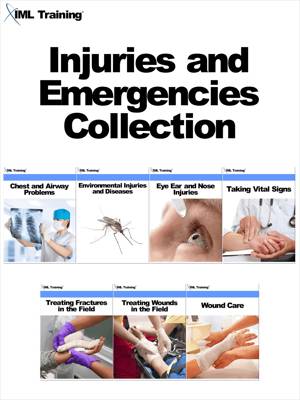
- Afhalen na 1 uur in een winkel met voorraad
- Gratis thuislevering in België vanaf € 30
- Ruim aanbod met 7 miljoen producten
- Afhalen na 1 uur in een winkel met voorraad
- Gratis thuislevering in België vanaf € 30
- Ruim aanbod met 7 miljoen producten
Omschrijving
Injuries and Emergencies Collection
This collection includes 7 of our training courses all within one book. You can easily use the bookmarks to navigate between each training course. This collection includes:
- Chest and Airway Problems
- Environmental Injuries and Diseases
- Eye Ear and Nose Injuries
- Taking Vital Signs
- Treating Fractures in the Field
- Treating Wounds in the Field
- Wound Care
Full illustrations and diagrams included.
Chest and Airway Problems
In this course Chest and Airway Problems, you will study chest and airway problems. Chest trauma refers to general information about chest injuries as well as information about specific chest injuries. Airway problems includes information on devices such as the esophageal obturator airway, the esophageal gastric tube airway and the endotracheal tube. All of these devices can be used to open and maintain an airway. If other life-saving methods are not successful in opening and maintaining an airway, an opening is made in the trachea to bypass the site of an upper airway obstruction. This subject matter is of vital importance in saving lives and included within this course.
Environmental Injuries and Diseases
This course on environmental disease and injuries includes sections on venomous snake bites, spider bites, insect stings and bites, anaphylactic shock, poisonous marine animals, and hepatitis. The identification of types of snake bites and types of venoms is the main concern of the section on snakes. The spiders that are identified can be as lethal as some types of snakes, but many of the insects are not. These insects are included because they are medically important, in terms of pain and the possibility of an allergic reaction. Many people can show an allergy that will progress to anaphylactic shock. Some types of marine life can emit a poison that is more lethal than that of any snake. The lesson on hepatitis identifies the various types of this disease. The routes of person to person transmission, and disease precautions, will be of special interest.
Eye, Ear and Nose Injuries
Injuries to the eye, ear, and nose can be very sensitive to the patient. You must use extreme care when working with these patients. This course describes procedures for treating and dressing injuries to the eye, irrigating and applying medication to the eye, irrigating the ear, and treating nosebleed.
Taking Vital Signs
Vital (life) signs are very important. They tell you about the patient's present condition. This course provides you with information you need in order to take a person's vital signs.
Treating Fractures in the Field
One of the more common injuries in everyday life is a fracture. Although usually not immediately life-threatening, serious fractures can be fatal if not properly treated. This course discusses the procedures for immobilizing fractures and dislocations of the extremities using traction splints, wire ladder splints, SAM splints, pneumatic splints, and improvised splints. The course also covers immobilizing a casualty with a suspected fracture of the spine.
Treating Wounds in the Field
When you have a casualty, you must determine the sequence in which the casualty should be treated and decide how to treat their injuries. This course discusses the procedures for performing primary and secondary surveys; performing triage; treating open and closed injuries of the extremities, chest, abdominal, and head; and controlling shock.
Wound Care
In this course, you will study wound healing, wound care, contaminated wounds, and burns. Information you read in this course will aid you in maintaining and improving the health of a patient.
Specificaties
Betrokkenen
- Auteur(s):
- Uitgeverij:
Inhoud
- Taal:
- Engels
- Reeks:
Eigenschappen
- Productcode (EAN):
- 9781782582564
- Verschijningsdatum:
- 22/08/2013
- Uitvoering:
- E-book
- Beveiligd met:
- Adobe DRM
- Formaat:
- ePub

Alleen bij Standaard Boekhandel
Beoordelingen
We publiceren alleen reviews die voldoen aan de voorwaarden voor reviews. Bekijk onze voorwaarden voor reviews.











